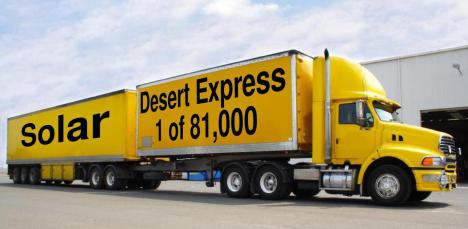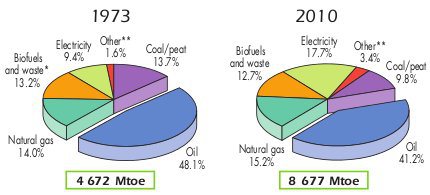Guest Post by Geoff Russell. Geoff is a mathematician and computer programmer and is a member of Animal Liberation SA. He has published a book on diet and science, CSIRO Perfidy.
What’s a solar atlas?
The World Wildlife Fund (WWF) recently released its World Solar Atlas report reckoning that the world’s entire projected needs in 2050 of something beginning with “e” could be met with solar panels on less than one percent of the planet’s surface. Pundits covering the report suffered some confusion about whether the ‘e’ was ‘electricity’ or ‘energy’, but none bothered with the obvious implication that covering one percent of Australia, for example, in solar power stations would require trucks as well as panels and land. Extrapolating from the proposed Moree Solar Farm project shows that this “one percent solution” would keep our entire 81,000 strong articulated truck fleet busy lugging stuff out into the bush for a minimum of four years and involve some 50 million round trips. That’s right, all the semi-trailers, all the B-Doubles, and all the road trains. All diverted from goods transport, food harvests and whatever else they do and all doing nothing else but carting solar stuff for four full years. Allocating 8,000 of the fleet to the build would see it stretch out to four decades. Read on for the details…
 I didn’t see any mainstream media coverage of the WWF report, but then again, the Lance Armstrong soapie broke at about the same time and didn’t leave much room for other news. So coverage was left to the renewable energy bloggies.
I didn’t see any mainstream media coverage of the WWF report, but then again, the Lance Armstrong soapie broke at about the same time and didn’t leave much room for other news. So coverage was left to the renewable energy bloggies.
Here’s a sample of the headlines: “… Solar power could serve all the World’s Energy Needs”, and “… solar panels in harmony with nature”, and “…land requirements insignificant”, and “solar could power entire world with less than 1% of land mass”.
“Bloggie” is a neologism related fairly clearly to “groupie” and I’m expecting it to go viral.
Here’s a couple of typical paragraphs that illustrate the coverage:
Highlighting the fact that a global switch to renewable energy is not just necessary, but doable, a new report released by the WWF concludes that the solar arrays necessary to meet all the world’s projected energy needs in 2050 would cover under one percent of global land area. Obviously this is a theoretical exercise, and 100 percent of the planet’s electricity needs are not actually going to be filled through solar.
and
The report illustrates that PV technology, when well-planned, does not conflict with conservation goals and clarifies that no country or region must choose between solar PV and space for humans and nature.
Electricity? Energy? Both start with ‘e’
What’s the problem? Well the problems begin with the letter ‘e’. Globally, electricity is only about 18 percent of energy use (IEA). So meeting all the world’s energy needs is very different from meeting all the world’s electricity needs.
 Both needs begin with ‘e’ but getting them confused is no minor matter.
Both needs begin with ‘e’ but getting them confused is no minor matter.
Filed under: Policy, Renewables | 1 Comment »






.png)





